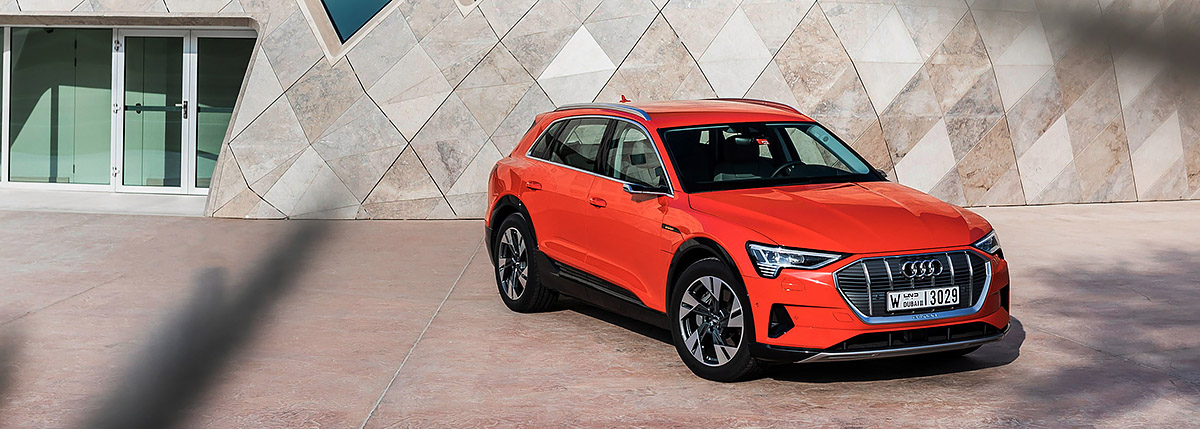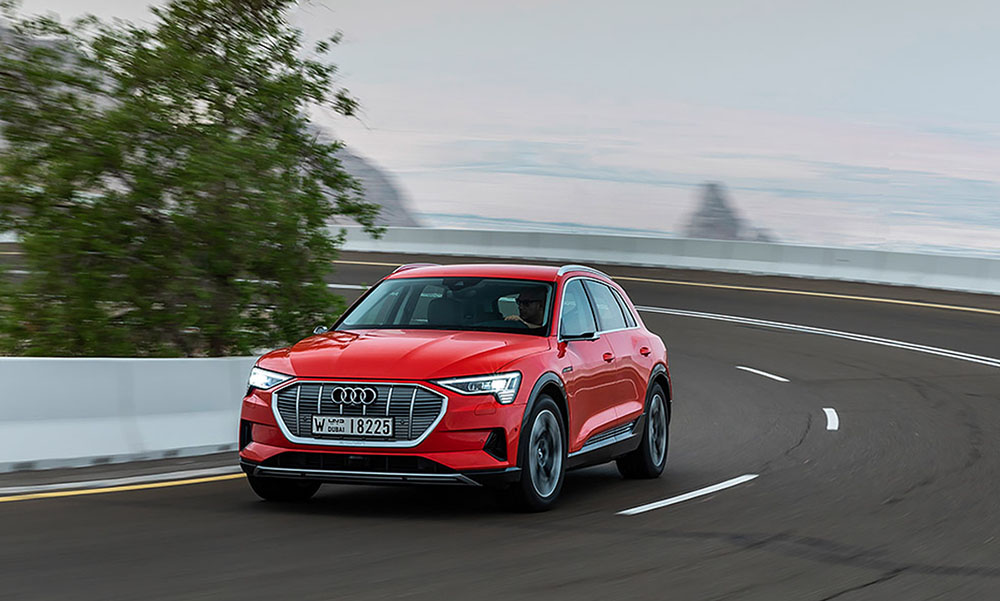Test drive: Audi e-tron

Overview
It’s a very conventional Audi. That’s probably the first thing to note about the e-tron. This is an electric car that doesn’t seek to blur boundaries or act radical, but simply persuade regular SUV buyers to make the jump. Audi refers to this as ‘concept clarity’.
The Tesla Model X deliberately looks and feels different, the Jaguar I-Pace is part SUV, hatch, crossover and coupe, both pitched that way to make an impact and try to pull in buyers from all over. Both need growth. But Audi, defending huge sales volumes, has created a car people will recognise, understand.
Although similarly sized, underneath the e-tron bears little resemblance to a Q7. It isn’t ground-up new, but the MLB Evo platform has been heavily adapted to underpin both this and next year’s e-tron Sportback. There’s an electric motor on each axle, the rear slightly more powerful than the front for a total of 402bhp and 664Nm, and in between a 700kg, 95kwh battery pack.
The e-tron is built in Brussels, in the plant that used to assemble the A1 (that’s now moved to SEAT’s Martorell facility). Audi won’t talk sales volumes other than to say it’ll be built in similar numbers to the A1. The battery is built in a separate Brussels factory, and bolts direct to the bottom of the chassis.

Further electric platforms are in the pipeline at Audi. The e-tron GT concept shown recently is based on Porsche’s Taycan, while further down the line Audi and Porsche are working jointly on an all-new electric platform, known internally as PPE. That will form the base for the VW Group’s larger cars (possibly including Bentley) while VW’s own MEB platform will feature for its ID models.
Enough industry chat. This e-tron wears another badge: 55 (Audi’s daft designation for cars with 333-408bhp). It’s safe to assume e-trons with varying power outputs will be along shortly, including an entry-level version with a smaller battery. That might lower the range from the claimed 399 kilometres, but will also help drop the price of entry from £71,490 (RM376,000). A fast one is also in the pipeline.
The e-tron seats five (there’s no seven seat option – at this stage at least), and has a large 605-litre boot. Key equipment includes adaptive air suspension, LED headlights, 360 degree cameras, keyless and charging points on both sides of the vehicle while options include a world-first: this production car is available with side cameras instead of mirrors.
What is it like on the road?
As electric cars gain momentum, so they’re becoming more straightforward to drive. So no strange drive modes in the Audi, nothing we’re unfamiliar with from their regular internal combustion models. The most complex thing about the e-tron is its new gearlever, which pivots from under its central housing, swinging over a small arc back into Drive or forward into Reverse. You get used to it in seconds.
And the rest of the e-tron. It’s a car, just quieter and smoother. There are selectable driving modes from Off-road to Efficient to Dynamic, and the only pointers are these: in battery-saving Efficient the throttle response pulling out of junctions is way too sluggish, leaving you vulnerable to approaching traffic, in Dynamic the ride is perhaps a fraction more vivid than you want and in off-road the air suspension rises by 35mm for useful extra clearance.
But you leave it in default Comfort for 90 per cent of the time, maybe using one of the others via the buttons on the centre console if you’re in a field/on a B-road/feeling worthy.
Because the e-tron’s based on an adapted platform, it’s a heavy car. Very heavy. 2,490kg heavy, over 300kg more than an I-Pace, 150kg up on a Tesla Model X 75D. The I-Pace is much zestier to drive, the Model X speedier. Not that the e-tron feels heavy. Even without the clever 48-volt electronics that underpin the Audi SQ7 and Bentley Bentayga, it doesn’t roll much or heave around corners. The benefits of a low centre of gravity. It controls its weight well, grips and changes direction more tenaciously than expected. More tenaciously than most regular SUVs. The rear motor is more powerful, torque split roughly 40:60. The ride is smooth, aided by tyres that aren’t too aggressively low-profile – 255/50 R20s. 21s are available.
The electric motors are sprightly enough to mask the weight, too. The e-tron feels alert off the line and has a reasonable snap of acceleration even at motorway speeds. But it’s not fast. Not by electric standards. Audi claims 0-100kph in 5.7secs. The I-Pace is a second ahead at that point. But it’s fast enough. This side of Audi’s own SQ7 you don’t get a diesel SUV accelerating this punchily.
Top speed is limited to 200kph. I asked the autobahn-obsessed Germans whether this was an issue. Not once they realised how much a higher top speed would reduce the range by apparently. They went on to mention that the shift to electric might move the conversation away from high top speeds. Interesting.

So the e-tron grips well and is comfortable, the controls have (with the exception of step-off in Efficient mode) been calibrated very well indeed so input matches response. But it’s not a communicator. Nothing through the steering, nothing through the brakes, except a realisation that 2,490kg takes an extra ounce or two of pedal weight when you’re coming to a stop.
Below 0.3g of retardation (it’s more than you think) the braking is done electrically through the motors, the recuperated energy fed back into the battery. Only beyond that point are the hydraulic discs pressed into service. You don’t notice the handover. Paddles behind the steering wheel allow you to increase the recuperation through two levels – lift off while moving and you’ll normally just coast, but you can choose to decelerate (like downshifting an auto gearbox) and even if you don’t, the system is clever enough to know a roundabout is approaching and gently start the slowing for you.
But all this is very surreptitious. The idea is that the car shouldn’t do anything that might alarm you in the slightest. It takes no risks whatsoever.
The refinement is uncanny. Not only the lack of road noise thanks to tyres with foam linings to reduce cavitation, but the silence from the absent door mirrors, here replaced by camera stalks, reducing overall width by 150mm. You notice a trace of wind noise from the base of the windscreen and A and B-pillars, but not for long. While out driving the e-tron I rode in a regular internal combustion Q7. It felt harsh when it started up, I noticed the noise and vibration. For several miles I assumed it was a diesel. It wasn’t. The game has moved on.
Small, but potentially useful point – the e-tron features charge points on the front wings both sides. They accept charge at up to 150kw (a Tesla supercharger runs at 120kw), meaning 80 per cent charge can be achieved in 30 minutes. You’re more likely to be charging at home, though, probably at 11kw, although Audi offers an optional 22kw fast charger.
Audi claims a range of 399km from the 95kwh battery. It would go further if it weighed less (the next generation PPE platform cars will be lighter). Indications from our drive suggest you should expect around 322 kilometres between charges.
Layout, finish and space
Imagine a Q7, then make the cabin design a notch more futuristic and knock back the practicality a notch. Maybe two, actually. The boot has a very high load sill and the angled D-pillars cut into space. You’ll need an athletic dog to make it up there and it’ll have to watch headroom once it’s loaded.
There’s also a frunk. It’s shallow, but a good place for charging cables so they don’t clutter up the regular boot. Meanwhile the middle seat occupant in the back (only a five seater, remember) has little legroom. The floor might be flat, but the cenre console that runs between the front seats protrudes back far enough to clout unwary shins. Flanking seats are… fine. Not generous by class standards, merely acceptable.
There are five screens up front. Two in the centre console, another full width dash screen for Audi’s peerless Virtual Cockpit, and two more on the doors either side. These are the screens for the side view cameras. They’re not perfect. Think about how much you move your head to alter your angle of view when joining a motorway. You can’t do that here. You get used to the positioning of the screens (could be a gnats higher ideally), can adjust the brightness, angle of view and grateful that they cut aero drag and you don’t need to look around bulky mirrors any more, but the angle of view is narrow, and in strong sun they struggle
The driving position is great, seat comfort superb and quality irreproachable. It is an Audi, it’s what they do. You will be spending a lot of time interacting with screens. The menu system is logical, at no stage does the e-tron bombard you with electric graphs, charts and data. Quite hard to find it, actually and those that like to geek out on that sort of thing are going to be disappointed. It’s short on detail.















Final thoughts and pick of the range
The family SUV, made electric. The Audi e-tron may be unimaginative, it may not stand out from the crowd, but that’s the point. This is a key part of the electric car tipping point, aimed at drawing in those who want an electric car, but don’t want it to weird them out. This applies to the vast majority of buyers out there, and the e-tron, although £15,000 more than an equivalent diesel SUV, is likely to find many eager homes.
It’s an easily understood, very well executed and reassuringly well built and developed car. An Audi, in other words. It would be good if it was lighter and went further between charges and we’re yet to be convinced about the benefits of the camera side mirrors, but if you’re looking to set a tentative foot into the future, this is the safest stepping stone yet.















